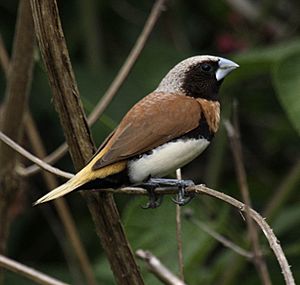Chestnut-breasted mannikin facts for kids
Quick facts for kids Chestnut-breasted mannikin |
|
|---|---|
 |
|
 |
|
| Conservation status | |
| Scientific classification | |
| Genus: |
Lonchura
|
| Species: |
castaneothorax
|
| Subspecies | |
|
|
 |
|
| range | |
The chestnut-breasted mannikin (Lonchura castaneothorax) is a small bird. People also call it the chestnut-breasted munia or bully bird in Australia. It has a brown back, a black face, and a greyish head. You can spot a wide reddish-brown band across its chest, above a white belly. This bird lives in Australia, New Caledonia, Indonesia, and Papua New Guinea. It has also been brought to French Polynesia and France.
Contents
Types of Chestnut-breasted Mannikins
There are six main types, or subspecies, of the chestnut-breasted mannikin. Each type lives in a different area and has slight differences.
- L. c. castaneothorax – This is the main type. It lives in eastern Australia.
- L. c. assimilis – Found in northern Australia. It has a richer chest color and a creamier belly.
- L. c. ramsayi – Lives in southeastern Papua New Guinea. This type has a distinct black head.
- L. c. boschmai – Found near Lake Wissel in Irian Jaya. It has brown patterns on its sides.
- L. c. sharpii – Lives in Hollandia, Irian Jaya, and Papua New Guinea. This type has a pale grey head.
- L. c. uropygialis – Found in Geelvink Bay in western Irian Jaya. Its head is not as pale, and it has orange on its upper tail feathers.
The chestnut-breasted mannikins in Tahiti likely came from the L. c. castaneothorax type. They now have paler undersides and more patterns on their necks.
Where They Live
In Australia, chestnut-breasted mannikins like to live near water. They are often found in areas with tall reeds and grasses along rivers and swamps. You can also see them in grassy fields and even in sugar cane or cereal crops. During dry times, they might go to drier places, but they always stay close to water. They also live in woodlands with grass.
In New Guinea, these birds prefer drier areas. They are not usually found in thick jungles.
In French Polynesia, where they were introduced, they have adapted well. They live in many different places, like grassy hills, gardens, farms, and even coconut farms. This shows how flexible they are!
What They Do and Eat
During the time they raise their young, chestnut-breasted mannikins are usually seen in pairs. But in late autumn and winter, they gather in large groups. Sometimes these big groups eat seeds from cereal crops.
These birds are very social. They often form large flocks when they are not breeding. Even when they are breeding, they might join groups to find food.
They really like barley seeds, which is why some people call them "barley birds." They also enjoy eating seeds from paspalum grass, bullrush millet, and sorghum. In Papua New Guinea, they have been seen eating wild millet and wild sugar cane.
Where They Came From
Scientists study the origin of birds to understand where they came from. Research suggests that birds like the chestnut-breasted mannikin, which belong to the Estrildinae family, might have first appeared in India. From there, they spread out to places like Africa and the Pacific Ocean.
See also
 In Spanish: Capuchino pechicastaño para niños
In Spanish: Capuchino pechicastaño para niños




